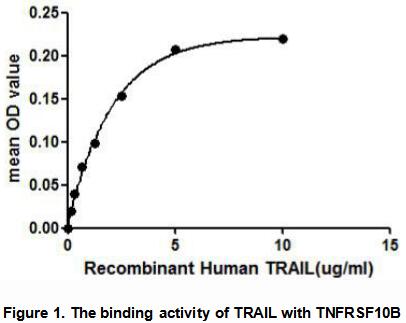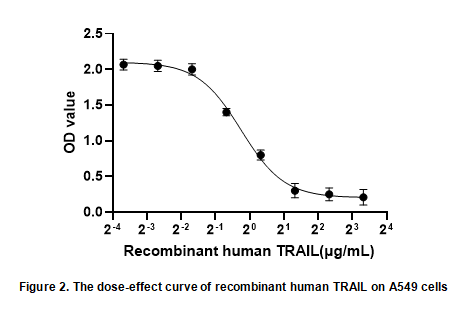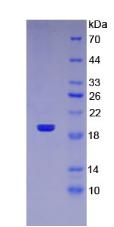Active Tumor Necrosis Factor Related Apoptosis Inducing Ligand (TRAIL) 

CD253; TNFSF10; APO2L; Apo2-L; TL2; TRAIL; Tumor Necrosis Factor Ligand Superfamily Member 10; Apo-2 Ligand
Overview
Properties
- Product No.APA139Hu01
- Organism SpeciesHomo sapiens (Human) Same name, Different species.
- ApplicationsCell culture; Activity Assays.
Research use only - DownloadInstruction Manual
- CategoryApoptosisTumor immunity
- Buffer Formulation20mM Tris, 150mM NaCl, pH8.0, containing 1mM EDTA, 1mM DTT, 0.01% SKL, 5% Trehalose and Proclin300.
- Traits Freeze-dried powder, Purity > 95%
- Isoelectric Point8.6
Sign into your account
Share a new citation as an author
Upload your experimental result
Review

Contact us
Please fill in the blank.
Activity test

Protein TRAIL (TNF-Related Apoptosis-Inducing Ligand) is a cytokine that belongs to the tumor necrosis factor (TNF) ligand family. TRAIL induces apoptosis in transformed and tumor cells. This protein binds to several members of TNF receptor superfamily including TNFRSF10B/TRAILR2. Thus a binding ELISA assay was conducted to detect the interaction of TRAIL and TNFRSF10B. Briefly, recombinant human TRAIL were diluted serially in PBS, with 0.01%BSA (pH 7.4). Duplicate samples of 100uL were then transferred to TNFRSF10B-coated microtiter wells and incubated for 2h at 37°C. Wells were washed with PBST and incubated for 1h with anti-TRAIL pAb, then aspirated and washed 3 times. After incubation with HRP labelled secondary antibody, wells were aspirated and washed 3 times. With the addition of substrate solution, wells were incubated 15-25 minutes at 37°C. Finally, add 50µL stop solution to the wells and read at 450nm immediately. The binding activity of TRAIL and TNFRSF10B was shown in Figure 1, and this effect was in a dose dependent manner.

Tumor Necrosis Factor Related Apoptosis Inducing Ligand (TRAIL) is a recently identified member of the TNF gene superfamily. TRAIL is widely expressed in a variety of human tissues, most predominantly in lung, spleen and prostat. As its name suggests, TRAIL was primarily of particular interest for its ability to selectively induce apoptosis in tumour cells in vitro and in vivo, while apparently exhibiting minimal off-target effects. In order to test the effect of human recombinant TRAIL protein on cell apoptosis, 2x104 A549 cells were seeded into quintuplicate wells of 96-well plates and allowed to attach, replaced with various concentrations of recombinant human TRAIL. After incubated for 72 hours, the 96-well plates were read at OD450 nm. The result was shown in Figure1. It was obvious that rmTRAIL significantly decreased cell viability of A549 cells. The ED50 of recombinant human TRAIL is 0.84 μg/mL.
Usage
Reconstitute in 20mM Tris, 150mM NaCl (pH8.0) to a concentration of 0.1-1.0 mg/mL. Do not vortex.
Storage
Avoid repeated freeze/thaw cycles. Store at 2-8°C for one month. Aliquot and store at -80°C for 12 months.
Stability
The thermal stability is described by the loss rate. The loss rate was determined by accelerated thermal degradation test, that is, incubate the protein at 37°C for 48h, and no obvious degradation and precipitation were observed. The loss rate is less than 5% within the expiration date under appropriate storage condition.
Increment services
-
 BCA Protein Quantification Kit
BCA Protein Quantification Kit
-
 Molecular Mass Marker for Protein
Molecular Mass Marker for Protein
-
 Monoclonal Antibody Customized Service
Monoclonal Antibody Customized Service
-
 Polyclonal Antibody Customized Service
Polyclonal Antibody Customized Service
-
 Protein Activity Test Experiment Service
Protein Activity Test Experiment Service
-
 Electrophoretic Mobility Shift Assay (EMSA) Experiment Service
Electrophoretic Mobility Shift Assay (EMSA) Experiment Service
-
 Buffer
Buffer
-
 Lentivirus Packaging Experiment Service
Lentivirus Packaging Experiment Service
-
 Adenovirus Packaging Experiment Service
Adenovirus Packaging Experiment Service
-
 Real Time PCR Experimental Service
Real Time PCR Experimental Service
-
 Spike RBD Protein (S-RBD)
Spike RBD Protein (S-RBD)
-
 Protein G
Protein G
-
 Protein A
Protein A
Citations
- Intranasal Administration of Recombinant TRAIL Down-Regulates CXCL-1/KC in an Ovalbumin-Induced Airway Inflammation Murine ModelPubmed:25506835
- Soluble TRAIL Concentration in Serum Is Elevated in People with HypercholesterolemiaPubMed: 26633016
- Non-alcoholic fatty liver disease, vascular inflammation and insulin resistance are exacerbated by TRAIL deletion in micepubmed:28507343
- TRAIL and TRAIL Receptors as Prognostic Markers in Breast Cancer PatientsPubmed: 31183506
- Nifuroxazide attenuates experimentally-induced hepatic encephalopathy and the associated hyperammonemia and cJNk/caspase-8/TRAIL activation in ratsPubmed: 32259601
- Cardio-protective impact of gabapentin against doxorubicin-induced myocardial toxicity in rats; emphasis on modulation of inflammatory-apoptotic signalingPubmed: 33199237
- Chemo-preventive effect of crocin against experimentally-induced hepatocarcinogenesis via regulation of apoptotic and Nrf2 signaling pathwaysPubmed: 32942000
- Tranilast abrogates cisplatin©\induced testicular and epididymal injuries: An insight into its modulatory impact on apoptosis/proliferation34047436









